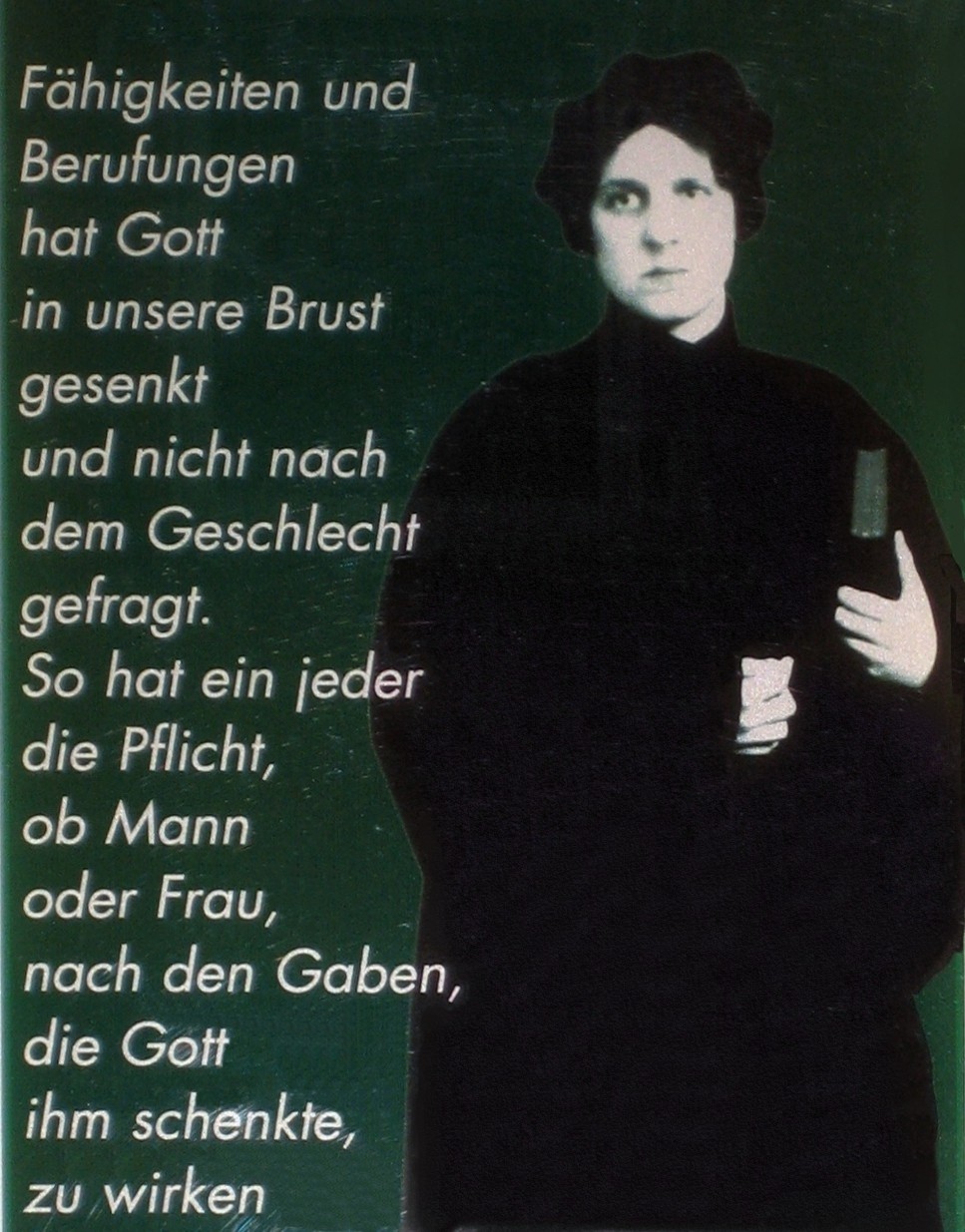- Regina Jonas
Infobox Rabbi
honorific-prefix =
name = Regina Jonas
honorific-suffix =
title =
caption = Memorial tablet for Regina Jonas,
began =
ended =
predecessor =
successor =
semicha =
rabbi =
rank =
other_post =
birth_name =
birth_date =August 3 ,1902
birthplace =Berlin
death_date =December 12 ,1944
deathplace =
buried =
nationality =
religion =
residence =
parents =
spouse =
children =
occupation = Rabbi
profession =
employer =
alma_mater =
website =Regina Jonas (
August 3 ,1902 -December 12 ,1944 ) was aBerlin -bornrabbi . Historically, she was the first Jewish woman to pursue this career, be ordained and do social, theological and religious work as such.Early life
She became orphaned from her father when she was very young. Like many women at that time, she followed a career as a teacher but was not content. In Berlin, she enrolled at the "
Hochschule für die Wissenschaft des Judentums ", Higher Institute for Jewish Studies - the Academy for the Science of Judaism, and took seminary courses for liberal rabbis and educators. There she graduated as an "Academic Teacher of Religion."Jonas, with the goal of becoming a rabbi, wrote a thesis that would have been an ordination requirement. Her topic was "Can a Woman Be a Rabbi According to
Halachic Sources?" Her conclusion, based on Biblical, Talmudic, and rabbinical sources, proved that she should be ordained. However, theTalmud professor responsible for ordinations refused her. Jonas applied to RabbiLeo Baeck , spiritual leader ofGerman Jewry , who had taught her at the seminary. He also refused because her ordination would have caused massive intra-Jewish communal problems with the Orthodox rabbinate in Germany.On
December 27 ,1935 Regina Jonas received herSemicha and was ordained by the liberal RabbiMax Dienemann , who was the head of the Liberal Rabbis’ Association, inOffenbach, Hesse . Jonas found work as a chaplain in various Jewish social institutions while attempting to find a pulpit.Persecution and death
Because of Nazi persecution, many rabbis emigrated and many small communities were without rabbinical support. The duress of Nazi persecution made it impossible for Jonas to be a rabbi and to preach in a synagogue, and she was soon ordered into forced labor. Despite this, she continued her rabbinical work as well as to teach and preach.
On
November 4 ,1942 , Regina Jonas had to fill out a declaration form that listed her property, including her books. Two days later, all her property was confiscated "for the benefit of the German Reich." The next day,November 5 ,1942 the Gestapo arrested her and she was deported to Theresienstadt. She continued her rabbi work, andViktor Frankl , the well-known psychologist, asked her for help in building a crisis intervention service to improve the possibility of surviving by helping to prevent suicide attempts. Her particular job was to meet the trains at the station. There she helped people cope with shock and disorientation.Regina Jonas worked tirelessly in
Theresienstadt concentration camp for two years - her work including giving lectures on different topics - until she was deported toAuschwitz in the midth of October 1944, where she was murdered two months later. She was 42 years old.There have been many other gifted Jewish people giving lectures there,
Leo Baeck for example. [ [http://sharat.co.il/lel/terezin/list.htm List of Lecturers in Ghetto Theresienstadt] ] Most of them have been murdered. None of the famous survivors has ever mentioned her name or work at Terezin. There has not been research on the why, though. [Elisa Klapheck, "Fräulein Rabbiner Jonas: The Story of the First Woman Rabbi", introductory chapter: [http://media.wiley.com/product_data/excerpt/77/07879698/0787969877.pdf My Journey toward Regina Jonas] ]Life work and legacy
A hand-written list of 24 of her lectures entitled "Lectures of the One and Only Woman Rabbi, Regina Jonas," still exists and can still be found in the archives of Theresienstadt. Five lectures are about the history of
Jewish women . five deal with Talmudic topics, two deal with Biblical themes,. three with pastoral issues, and nine offer general introductions to Jewish beliefs, ethics, and the festivals.In 1972 the reform and reconstructionist movements in the USA began to ordain women rabbis. In 1995
Bea Wyler , who had studied at the JTS in New York, became the first woman rabbi in post war Germany at the Jewish community ofOldenburg .Bibliography
* Klapheck, Elisa. "Fräulein Rabbiner Jonas: The Story of the First Woman Rabbi", Toby Axelrod (Translated) ISBN 0-7879-6987-7
* Makarova, Elena, Sergei Makarov & Victor Kuperman. "University Over The Abyss. The story behind 520 lecturers and 2,430 lectures in KZ Theresienstadt 1942-1944". Second edition, April 2004, Verba Publishers Ltd. Jerusalem, Israel, 2004. ISBN 965-424-049-1, (Preface: Prof. Yehuda Bauer)
*Sarah, Elizabeth. "Rabbiner Regina Jonas 1902-1944: Missing Link in a Broken Chain" in "Hear Our Voice: Women in the British Rabbinate" by Sybil Sheridan. Univ. of South Carolina Press, 1998. ISBN 157003088X
*Von Kellenbach, Katharina. “’God Does Not Oppress Any Human Being’ The Life and Thought of Rabbi Regina Jonas,” in "Leo Baeck Year Book", 1994
* _________. “Denial and Defiance in the Work of Rabbi Regina Jonas” in "In God's Name: Genocide and Religion in the 20th Century", Phyllis Mack and Omar Bartov, eds. Berghahn Publishers, 2000External links
* [http://www.hagalil.com/deutschland/berlin/rabbiner/jonas.htm The First Woman Rabbi in the World]
* [http://www.smcm.edu/users/kvonkellenbach/jonas.htm St. Mary's college of Maryland] : Rabbi Regina Jonas Memorial page.
* [http://history1900s.about.com/cs/theresienstadt/index.htm "Theresienstadt Ghetto"]
* [http://www.haaretz.com/hasen/pages/ShArt.jhtml?itemNo=431619 A forgotten myth] by Aryeh Dayan
* [http://www.brightonandhoveprosynagogue.org.uk/sermon-regina-jones.htm Regina Jonas: "The one and only woman rabbi" during dark times] Rabbi Elizabeth Tikvah Sarah, August 3, 2002
* [http://www.bet-debora.de/jewish-women/history.htm A Case of Communal Amnesia] Rabbi Dr. Sybil Sheridan, 16 May 1999Notes
Wikimedia Foundation. 2010.
